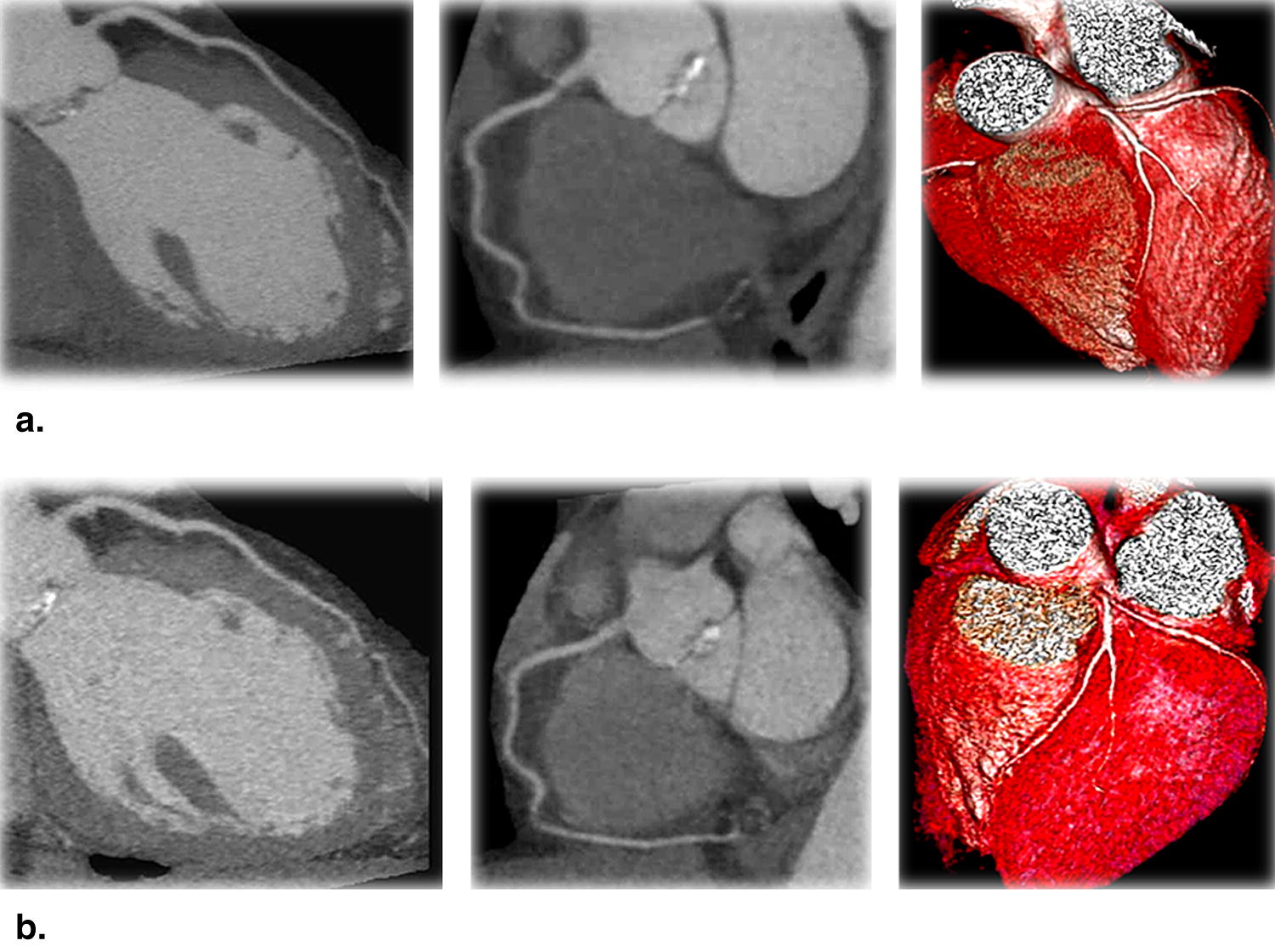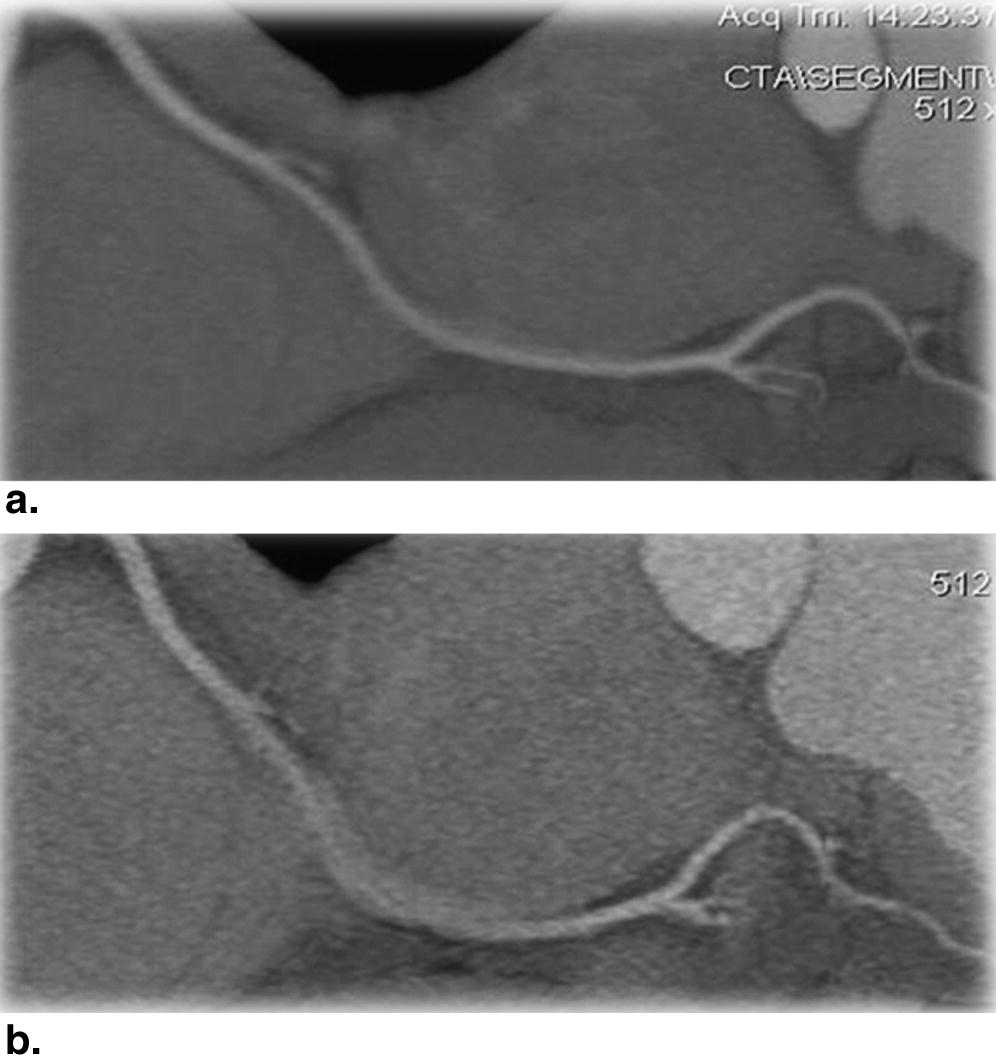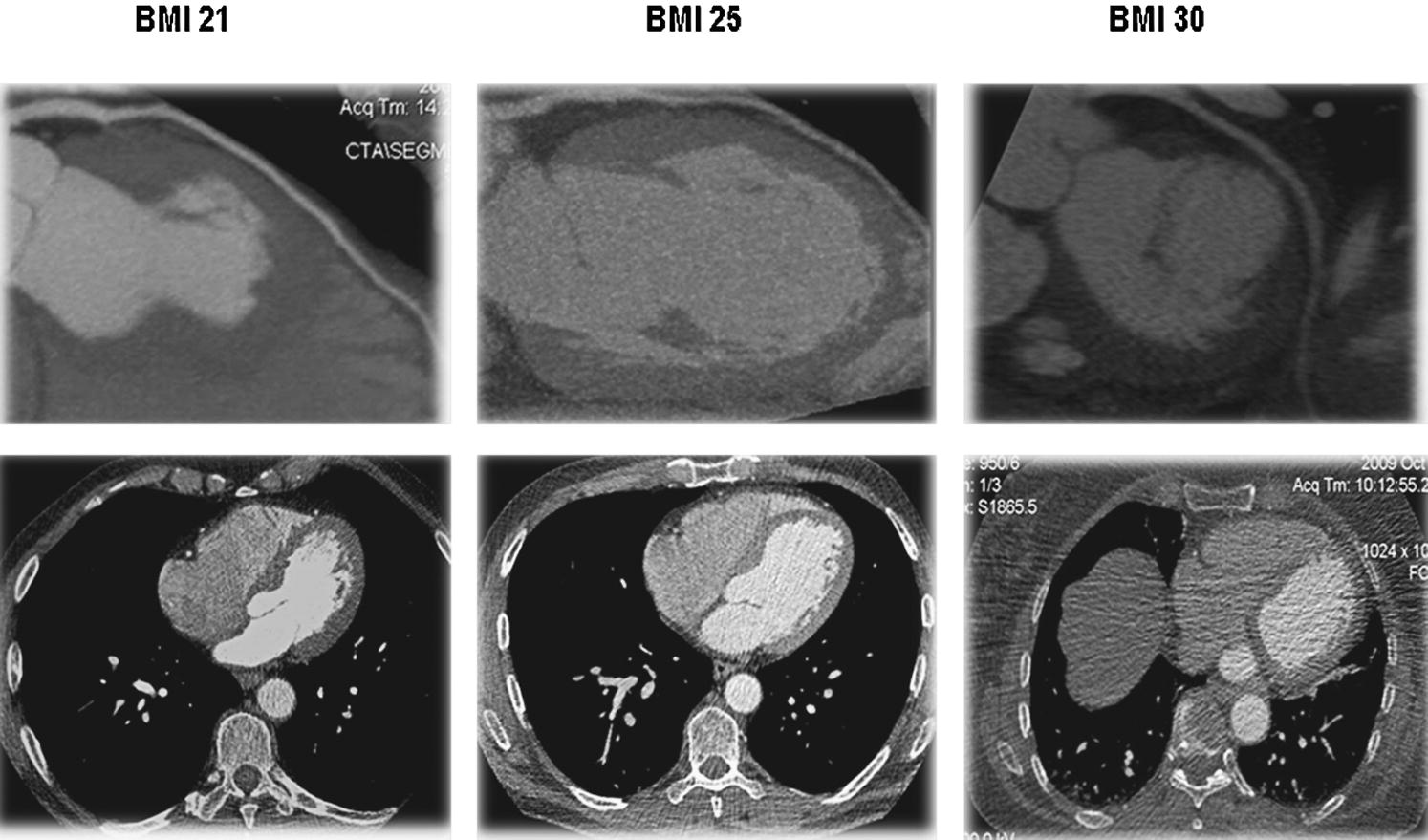Rationale and Objectives
Concerns for patient’s risk of radiation-induced cancer have increased demand for reduced-dose coronary computed tomography angiography (CCTA). Previous comparisons of full and reduced-dose CCTA were not conclusive, because results were compared in different groups of patients. Presented here are results in patients examined by a widely used full dose CCTA protocol and a new low-dose alternative.
Materials and Methods
Standard full-dose and low-dose CCTA with tube voltages of 120/100 kV were applied on 70 patients with intermediate probability of coronary artery disease (CAD). Both protocols used prospective electrocardiogram-gated acquisition on a 320-detector row CT scanner, whereas at low-dose CCTA the phase window was increased from 10% to 75% of R-R interval.
Results
Despite a mean dose reduction of 80%, from 4.9 ± 0.98 to 0.98 ± 0.24 mSv, visual image quality was not significantly affected at the low-dose protocol. Contrast level, image noise, and CNR for both protocols were similar in the majority of coronary segments. CNR for standard and low-dose protocol were 23.7 ± 17.1 and 23.2 ± 26.8, P = NS. Correlation between visual image quality and heart rate variability was strong at low dose: r = −0.58, P = .01, and absent at full dose: r = −0.07, P = .77.
Conclusion
Image quality of blood vasculature is generally not affected by 80% CCTA dose reduction applied to standard prospective electrocardiogram-gated acquisition. The performance at the low-dose protocol owes to the increased phase window, enhancing image quality at the cost of sensitivity to heart rate variability as compared with standard CCTA.
During the past decade, there has been a dramatic increase in the number of computed tomography (CT) examinations performed worldwide. The principal concern for any patient undergoing a diagnostic CT examination is the risk of developing a radiation-induced cancer, which may be fatal or nonfatal . Reducing the radiation dose while maintaining highest image quality possible has therefore become an important research topic. Furthermore, with existing helical CT systems, the z -coverage is limited to maximum 4 cm data acquisition in a single rotation. Any future use of additional rotations to cover the whole heart by the helical acquisition method will increase the radiation dose, the amount of which depends on the pitch.
Low-dose coronary CT angiography (CCTA) has recently been used in several studies . However, direct comparison in terms of image quality assessment between low-dose and standard full-dose protocols on the same group of patients is still lacking. The purpose of this study is to present a quantitative comparison of image quality for two scanning protocols applied in the same patient examination: full-dose (standard CCTA with tube voltage 120 kV) and a new low-dose protocol with tube voltage 100kV. Both protocols use prospective electrocardiogram (ECG)-gated acquisition on a 320-detector row CT scanner. This way, acquisition of the whole heart is achieved during a single heart beat in nonhelical scan acquisition. At the resulting exposure and scan time of just 0.35 seconds, the radiation dose is considerably reduced compared with helical data acquisition. Prospective ECG-gating also presents an opportunity for widening cardiac phase window still within one heart beat, a technique called padding ( Fig 1 ). This technique, which allows for the reconstruction of more cardiac phases within a single heart beat, still without pitch value (pitch = 0), has been implemented in the new low-dose protocol by increasing the phase window from the standard setting of 10% to 75% of R-R interval.
Figure 1
(a) Prospective electrocardiogram-gated acquisition method aiming at 70%–80% of R-R interval and (b) padding of for example 40%–80% of R-R interval. The height of the pulse represents the z -coverage.
Get Radiology Tree app to read full this article<
Materials and methods
Patient Population
Get Radiology Tree app to read full this article<
Scan Protocol
Get Radiology Tree app to read full this article<
Get Radiology Tree app to read full this article<
Get Radiology Tree app to read full this article<
Get Radiology Tree app to read full this article<
Visual Image Quality Assessment
Get Radiology Tree app to read full this article<
Get Radiology Tree app to read full this article<
Get Radiology Tree app to read full this article<
Evaluation of the Effective Radiation Dose
Get Radiology Tree app to read full this article<
Get Radiology Tree app to read full this article<
Results
Get Radiology Tree app to read full this article<
Get Radiology Tree app to read full this article<
Quantitative Assessment of Diagnostic Performance
Get Radiology Tree app to read full this article<
Get Radiology Tree app to read full this article<
Table 1
Quantitative Analysis Results of CCTA Image Quality Parameters in Various Regions Measured After Contrast Administration
Region Standard Protocol Attenuation (HU) Image Noise (HU) CNR Low-dose Protocol Attenuation (HU) Image Noise (HU) CNR_P_ Value Ascending aorta 408.7 ± 90.4 388.3 ± 117.9 NS 11.2 ± 6.7 12.7 ± 3.7 NS 62.4 ± 68.7 34.9 ± 21.4 .002 Left ventricle 374.7 ± 95.5 360.2 ± 96.3 NS 14.9 ± 8.5 16.0 ± 6.7 NS 36.0 ± 26.2 26.6 ± 14.8 .01 Coronary arteries: left main 352.7 ± 81.1 366.9 ± 94.5 NS 16.0 ± 10.1 14.4 ± 6.1 NS 28.9 ± 15.1 30.3 ± 16.1 NS Coronary arteries: LAD proximal 319.9 ± 91.7 330.6 ± 89.7 NS 20.4 ± 9.7 18.7 ± 6.5 NS 19.4 ± 10.2 21.4 ± 8.7 NS Coronary arteries: LAD middle 316.6 ± 66.7 325.3 ± 89.8 NS 20.6 ± 10.7 18.6 ± 6.6 NS 16.2 ± 10.7 19.6 ± 15.3 NS Coronary arteries: LAD distal 242.7 ± 58.4 230.2 ± 58.9 NS 25.5 ± 12.7 25.8 ± 8.7 NS 11.3 ± 5.1 9.9 ± 4.3 NS Coronary arteries: Cx proximal 299.4 ± 73.5 324.1 ± 102.2 NS 18.3 ± 6.8 19.3 ± 9.7 NS 19.2 ± 9.8 22.7 ± 17.3 NS Coronary arteries: Cx middle 300.8 ± 68.9 308.9 ± 83.8 NS 17.8 ± 8.2 19.0 ± 7.2 NS 19.9 ± 9.1 18.6 ± 7.9 NS Coronary arteries: Cx distal 238.0 ± 54.9 260.1 ± 83.1 NS 24.0 ± 10.1 22.0 ± 6.8 NS 14.2 ± 12.5 12.8 ± 4.7 NS Coronary arteries: RCA proximal 345.0 ± 85.6 316.3 ± 67.4 .02 15.0 ± 5.2 17.4 ± 8.7 NS 27.0 ± 14.9 26.3 ± 25.0 NS Coronary arteries: RCA middle 310.9 ± 74.6 270.7 ± 66.2 .001 20.4 ± 8.8 23.1 ± 11.4 NS 20.1 ± 13.9 14.1 ± 6.7 .001 Coronary arteries: RCA distal 268.4 ± 78.9 276.9 ± 74.8 NS 24.4 ± 13.4 22.5 ± 11.6 NS 14.7 ± 8.2 18.1 ± 16.4 NS
CCTA, coronary computed tomography angiography; Cx, circumflex; HU, Hounsfield units; LAD, left anterior descending artery; NS, not significant; RCA, right coronary artery.
Get Radiology Tree app to read full this article<
Diagnostic Image Quality: Visual Assessment
Get Radiology Tree app to read full this article<
Get Radiology Tree app to read full this article<
Heart Rate Variability versus Image Quality
Get Radiology Tree app to read full this article<
Discussion
Get Radiology Tree app to read full this article<
Get Radiology Tree app to read full this article<
Get Radiology Tree app to read full this article<
Get Radiology Tree app to read full this article<
Get Radiology Tree app to read full this article<
Get Radiology Tree app to read full this article<
Get Radiology Tree app to read full this article<
Conclusion
Get Radiology Tree app to read full this article<
Get Radiology Tree app to read full this article<
References
1. Brenner D.J., Elliston C., Hall E., et. al.: Estimated risks of radiation induced fatal cancer from pediatric CT. AJR Am J Roentgenol 2001; 176: pp. 289-296.
2. Kitagawa K., Lardo A.C., Lima J.A.C., et. al.: Prospective ECG-gated 320 row detector computed tomography: implication for CT angiography and perfusion imaging. Int J Cardiovasc Imaging 2009; 25: pp. 201-208.
3. Hausleiter J., Bischoff B., Hein F., et. al.: Feasibility of dual-source cardiac CT angiography with high-pitch scan protocols. J Cardiovasc Comp Tomogr 2009; 3: pp. 236-242.
4. Earls J.P., Leipsic J.: Cardiac computed tomography technology and dose-reduction strategies. Radiol Clin North Am 2010; 48: pp. 657-674.
5. Heibron B.G., Leipsic J.: Submillisievert coronary computed tomography angiography using adaptive statistical iterative reconstruction—a new reality. Can J Cardiol 2010; 26: pp. 35-36.
6. Gibbons R.J., Chatterjee K., Daley J., et. al.: ACC/AHA/ACP-ASIM guidelines for the management of patients with chronic stable angina: a report of the American College of Cardiology/American Heart Association Task Force on Practice Guidelines (Committee on Management of Patients With Chronic Stable Angina). J Am Coll Cardiol 1999; 33: pp. 2092-2197.
7. Budoff M.J., Achenbach S., Blumenthal R.S., et. al., American Heart Association Committee on Cardiovascular Imaging and Intervention; American Heart Association Council on Cardiovascular Radiology and Intervention; American Heart Association Committee on Cardiac Imaging, Council on Clinical Cardiology: Assessment of coronary artery disease by cardiac computed tomography: a scientific statement from the American Heart Association Committee on Cardiovascular Imaging and Intervention, Council on Cardiovascular Radiology and Intervention, and Committee on Cardiac Imaging, Council on Clinical Cardiology. Circulation 2006; 114: pp. 1761-1791.
8. Menzel H.G.Schibilla H.Teunen D.European guidelines on quality criteria for computed tomography. Publication no. EUR 16262 EN.2000.European CommissionLuxembourg:
9. Ripsweden J., Brismar T.B., Holm J., et. al.: Impact on image quality and radiation exposure CT angiography: 100 kVp versus 120 kVp. Acta Radiol 2010; 8: pp. 903-909.
10. Labounty T.M., Earls J.P., Lepsic J., et. al.: effect of standardized quality-improvement protocol on radiation dose in coronary computed tomographic angiography. Am J Cardiol 2010; 106: pp. 1663-1667.
11. Feuchtner G.M., Jodocy D., Klauser A., et. al.: Radiation dose reduction by using 100 kV voltage in cardiac 64-slice computed tomography: a comparative study. Eur J Radiol 2010; 75: pp. e51-e56.
12. Zhang C, Zhang Z, Yan Z, et al. 320-row CT coronary angiography: effect of 100-kV tube voltages on image quality, contrast volume and radiation dose. Int J Cardiovasc Imaging. In press.

![Figure 2, (a) Vessel density (in Hounsfield units [HU]) in proximal and distal segments for standard and low-dose coronary computed tomography angiography protocol. Low dose vs. full dose, all: P < .0001. (b) Contrast-to-noise ratio (CNR) in proximal and distal segments for standard and low-dose protocol. Low dose vs. full dose, all: P < .0001. (c) Image noise (in HU) in proximal and distal segments for standard and low-dose protocol. Low dose vs. full dose, all: P < .0001.](https://storage.googleapis.com/dl.dentistrykey.com/clinical/ImageQualityinReducedDoseCoronaryCTAngiography/0_1s20S1076633211001978.jpg)


